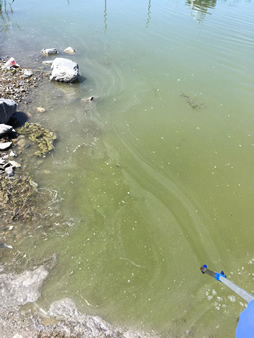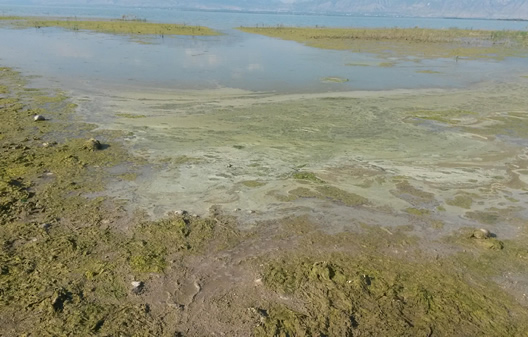News Article
August 9, 2017
BYU Researchers Study Utah Lake Algal Bloom
iUTAH researchers Erin Jones and Scott Collins, along with associate professor Zachary Aanderud and GAMUT technician, Dylan Dastrup, have been in the news recently in connection with their research of Utah Lake’s algae phenomenon. Here’s what the research team and state agencies had to say to reporter Anna Bryner, in an excerpt from the August 3 article in Brigham Young University’s The Daily Universe:
“‘Once isolated, we can put (the cyanobacteria) in controlled environments and manipulate just a few variables at a time to really establish the values for which the bacteria respond by either growing exponentially or producing toxins,’ Jones said.
The team will also analyze the nutrient levels of the varying forms of phosphorous and nitrogen in the lake. ‘We’ll be able to see what factors correlate with the algal growth for the different species that we find from sequencing,’ said Jones. ‘By (taking samples) weekly, we hope to be able to catch conditions leading up to blooms, which is where the environmental triggers actually occur.’
The researchers have also been collecting extra samples to send to the Utah Department of Environmental Quality, where the samples are analyzed to provide information to the public. ‘They’re a real big help for us because we don’t have the resources to go down there on a weekly basis,’ said Ben Holcomb, environmental scientist for the Utah Division of Water Quality.
According to Jones, collecting an extra sample for the department is ‘not really much of a sacrifice.’ ‘They’re spread pretty thin, so we’re happy to do what we can to help contribute to the public health awareness that the cyanobacteria represent,’ Jones said.
As part of the collaboration, the Utah Department of Environmental Quality provides data to the researchers about the analysis of the samples. ‘It saves us a little bit of money and time by them being able to provide that analysis for us,’ Jones said. According to Holcomb, the benefits are mutual. ‘We’re kind of complimenting each other on our needs, so it’s been a really helpful process,’ Holcomb said.
According to Donna Spangler, the Utah Department of Environmental Quality communications director, algal blooms are naturally occurring. The conditions that cause blooms to spread include sunlight, heat, stagnant water and an excess of nutrients. ‘Under certain environmental conditions … (algal bloom) certainly has a tendency to spread,’ she said.”
Read the full article below for more details on how the iUTAH/BYU research team and state agencies are working together to help protect public health.
Press: The Daily Universe | Deseret News


« Back to list of all news articles


